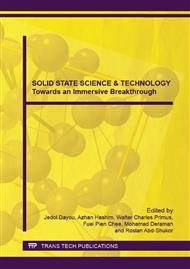p.577
p.582
p.589
p.595
p.601
p.606
p.611
p.616
p.625
Porosity Effect on Superconducting Properties of YBa2Cu3Oδ and YCaBa4Cu6Oδ
Abstract:
This paper reports on the properties of YBa2Cu3Od (Y123) and YCaBa4Cu6Oy (Y146) with non-porous and porous structures. The relationship between calcium doping and critical temperature (Tc) was studied to determine the optimal superconducting properties. A series of heating and grinding via solid state reaction method was used to fabricate the ceramic materials. The electrical properties were investigated via critical temperature, TC and critical current density, JC using the resistivity measurement system (RMS). Scanning Electron Microscope (SEM) and X-Ray Diffraction (XRD) were used to analyze the material morphology and structure, respectively. The orthorhombicity increased due to less porosity of the samples. The calcium presence partially replaced larger Ba(II) site and degraded orthorhombicity. The highest critical current density (JC) was porous YCaBa2Cu3Oy which was 2.32 A/cm2 compared to 0.75 A/cm2 for porous YCaBa4Cu6Oy at 60 K. The critical temperature for porous structure was less than non porous structure for Ca doped Y146 system which was 69.9 K and 67.9 K. SEM micrograph unveiled that the Jc was induced significantly by continuity of grain formation via grain size. Pores homogenized the grains surface quality and connectivity due to strain release thus increasing effective cross section of the sample for current density (Jc) over the vast areas.
Info:
Periodical:
Pages:
601-605
Citation:
Online since:
June 2015
Keywords:
Price:
Сopyright:
© 2015 Trans Tech Publications Ltd. All Rights Reserved
Share:
Citation:


